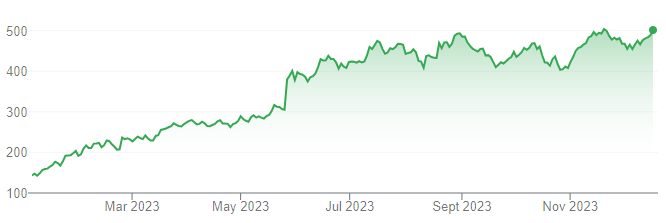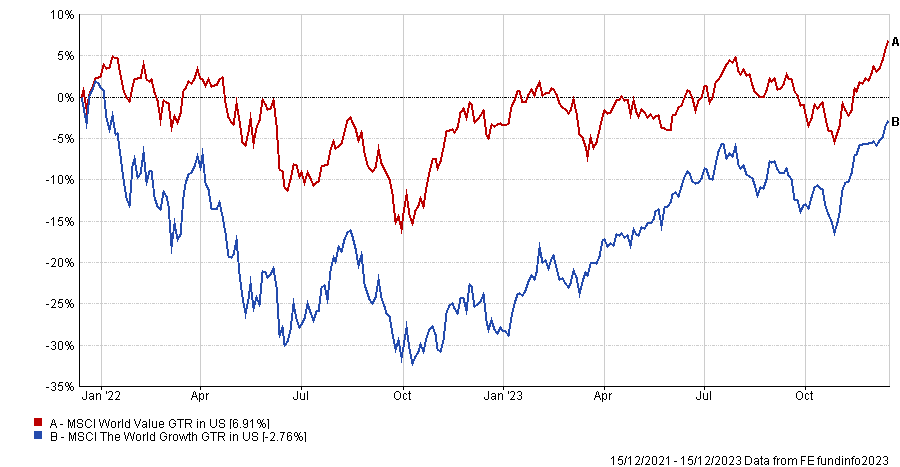The PGIM Jennison Global Opportunities fund has experienced a remarkable rebound in 2023, outperforming 98% of its global equity mutual fund peers year-to-date.
The strategy was tested during 2022 when it finished the year down 40% as central banks hiked interest rates rapidly to combat inflation, battering growth stocks in the process.
But a late 2022 visit to the executives of big tech companies in San Francisco gave the PGIM Jennison portfolio managers conviction to double down on AI as a theme which proved to be a fortuitous call as the year progressed.
Rebecca Irwin (pictured), one of the portfolio managers of the fund, told FSA: “We came back from that trip appreciating that this was going to be really, really big. This is the fourth era of technology, and we believe it’s going to be the biggest.”
One big change the portfolio managers made was sizing up meaningfully in Nvidia – a stock which has more than tripled year-to-date and forms the fund’s largest position at 7.6%.
Share price of Nvidia year-to-date

“We believe in concentration, and we focus on investing in innovative disruptive companies that are driving structural shifts in their industries,” Irwin said, describing the fund’s investment approach.
A lot of the team’s efforts revolve around looking for a select group of companies that share certain unique characteristics.
These are often companies launching a disruptive new product, a product that is better than existing competition, or selling a product into an expanding addressable market or an adjacency or that hadn’t been originally anticipated.
“We spend a lot of time on the competitive moat that these companies have because duration of growth is really important to us,” Irwin added.
“That can come from proprietary technology, from a network effect, economies of scale, perhaps a unique supply chain or speed to market, and all of that has to translate into superior financial characteristics.”
These financial metrics often show up as durable, high revenue growth, strong and expanding operating margins, good free-cash-flow generation, persistent earnings growth, and healthy balance sheets.
Invest in disruption early and don’t hang around too long
There are two things that sets the strategy apart from the countless number of growth-style mutual funds that have sprouted up after a decade of outperformance for the investment style.
One factor, according to Irwin, is their track-record of investing in innovation and disruption early, combined with their willingness to scale up position sizes. This enables them to generate alpha from their conviction.
This can be seen in the fund’s concentration, where it holds just 35 positions and its top 10 account for roughly 50% of its portfolio.
The other factor Irwin flagged is the sell-discipline. She said: “For a lot of growth investors, what tends to be the weak spot is the selling.”
“If we start to see fundamentals weakening at all, or we believe that market expectations have caught up to where we were on our thinking, so we will either trim the position size, or get rid of it altogether.”
“That dual combination of identifying innovation, but also not hanging around too long helps us consistently generate alpha.”
Although value stocks outperformed growth stocks during 2022 when the Fed was raising interest rates, Irwin argues that in the long-run, growth stocks tend to outperform due to the common characteristics of the businesses that typically fall into the ‘growth’ bucket.

She said: “Growth companies tend to be delivering to the consumer or to businesses a product or service that is needed, that is wanted.”
“The companies we invest in tend to be capital-light; you see really good margins, strong free-cash-flow, high earnings growth – and that’s really hard for a traditional value company to compete against for a long period of time.”
She also believes that despite being labelled “growth” investors, her team are investing in companies at what they think are compelling valuations.
“We just might be looking at different metrics,” she explained. “On a one-year view, the stock might look really expensive, but on a two- or three-year view, we think that the characteristics of that investment are very compelling.”
“So we’re growth investors, but we are disciplined on valuation too, just like value investors.”
Healthcare investing
Most generalist investors tend to shy away from making big bets on healthcare stocks because of the complexity of analysing the underlying science and regulatory environment.
But this is another area where the portfolio managers at PGIM Jennison have conviction. The strategy has meaningful overweight positions in Novo Nordisk and Eli Lilly at 5.1% and 4.7% respectively.
Both companies have soared year-to-date on the success of their weight-loss medicines (GLP-1’s) designed for adults with diabetes.
Irwin said what was interesting about these companies are the benefits that are being seen for their medicines outside of obesity.
She pointed to a recent study which found that diabetic patients taking GLP-1’s experienced 20% fewer heart attacks, strokes and deaths.
“That not only increases the addressable market outside of obese patients. Equally as importantly, it makes it harder for insurance companies and governments to not reimburse for the use of these GLP-1’s,” she explained.
“We think that Novo and Lilly will offer top-line growth, margin expansion, and earnings growth that is multiples of what a pharma company can traditionally offer.”
“A lot of investors are under appreciating both the magnitude of the growth and the duration of that growth,” she added.
“While the numbers do look expensive on a one-year basis but go even two-years out and they start to look very inexpensive.”

















